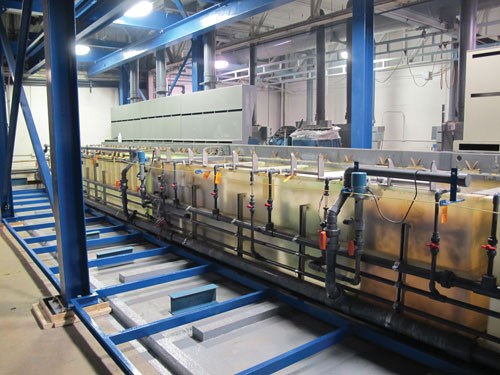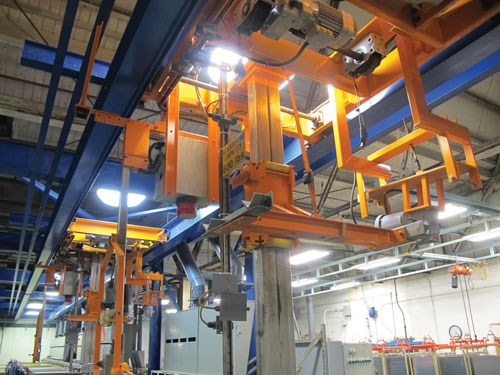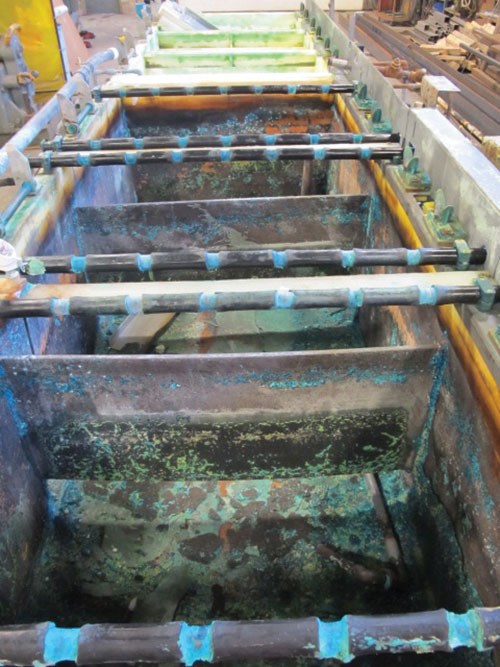Making Plating Lines New Again
PKG Equipment helps Monroe Plating in Rochester, New York revive a used line and give the shop extra flexibility.
John Rowe has never thought of himself as a “new car” kind of guy, preferring instead to kick the tires of a great used car that will get the job done for him just as well as a showroom model.
As general manager of Monroe Plating in Rochester, New York, he took that same approach when he joined the company four years ago when owner Ken McAlpin brought him on board to run the finishing company.
“Ken brought me on to grow this business,” Rowe says. “When I came on, our barrel line work was a shift a day, and after about two-and-a-half years, we grew it to where we were running it 24 hours a day, five days a week.”
So when he couldn’t fit more hours in a day to get additional work, Rowe started looking at adding capacity, which meant expanding Monroe’s operation and adding a new line.
“Our customers had the additional work for us,” he says. “We just couldn’t take it on.”
Monroe Plating specializes in electroless nickel and electroplated zinc in its 39,000-square-foot facility which has served the Rochester, Syracuse, Buffalo and all of upstate New York and Pennsylvania for 50 years.

Once Monroe purchased the line, they moved it to PKG’s facility to begin refurbishing it, as well as getting its own shop ready for its installation.
Roots to 1964
The company traces its roots back to 1964 when Frank McAlpin and Ralph Derleth cofounded McAlpin-Derleth Tool and Die in Rochester. After adding a stamping operation in 1965, the company grew to start Monroe Plating as an in-house finishing operation for zinc and electroless nickel plating.
McAlpin changed the company name in 1981 to McAlpin Industries after Derleth left the company. It is now a diversified precision metalworking company that provides sheet metal products, assemblies and services to the telecommunications, computer, business machine, office equipment, medical, transportation, voting equipment, electronic, warehouse management and automotive sectors.
When McAlpin retired in 1992, his sons Ken and Mike became president and vice president, respectively. The company has been one of Rochester’s most successful privately-owned companies for several decades.
Part of that success comes from knowing when to expand, and when to add services for customers, a challenge Rowe was tasked with solving when he needed to add capacity to Monroe Plating.
“I spent about a year looking at what alternatives we had to add capacity,” Rowe says. “And at the same time, I needed to show to my company management that we actually had work lined up if we spent money on a new line.”
Once Rowe received the go-ahead to start the project late in 2014, he worked with PKG Equipment in Rochester, a manufacturer and service provider of plating and process equipment. PKG Equipment Inc. has the capabilities to design, fabricate and install the equipment, while also servicing and rebuilding plating lines internationally.
PKG Experts
When Rowe met with Stephen Pontarelli, CEO of the family-owned PKG, they discussed both new and used equipment that would serve Monroe’s needs.
“John and I decided used would better fit their budget,” Pontarelli says. “Then it was a matter of finding the right equipment. There is nothing wrong with used equipment, as long as it is the ‘right’ used equipment.”
When Rowe got a lead on a used line that was available at a closed plant, he and Pontarelli went to look at it, though Pontarelli would not give his seal of approval for Monroe to take the line and move it back to their location.
“It was out in Connecticut,” Pontarelli says. “I told him we really needed to go out and evaluate it, and so we did. I told John I just didn’t think it would have made sense, and it just wasn’t the right line. The line was old, in poor condition, and the tanks were beyond their life expectancy.”
Because PKG not only builds new lines, and they spend a great deal of time servicing and rebuilding existing lines, Pontarelli advised Rowe to walk away. That advice came from years of experience, honed from Pontarelli’s father, Sam, who started PKG Equipment in 1969. Back then, Sam started with three employees in a small, 2,300-square-foot space where they fabricated metal tanks and racks for the plating industry.
National Finishing in Buffalo was PKG’s first customer, but Sam grew the business with other customers such as Eastman Kodak, Xerox and Bausch & Lomb.
PKG started fabricating plating equipment using thermoplastics during the 1970s. In the early ’80s, Sam bought plastic welding and forming machines from Europe to expand their plastic fabrication capabilities. PKG was one of the first companies in the U.S. to have that type of technology.

Two fully automatic hoists each have 180-pound maximum load capacity per barrel.
Expansion to More Equipment
Purchasing that equipment enabled PKG to begin offering turnkey plating systems. In the 1980s, PKG started expanding into other industries by custom fabricating several types of corrosion resistant process equipment, as well as making pharmaceutical skids, tanks for the chemical manufacturing industry and dry process equipment for material handling.
The additional services grew PKG and enabled the company to buy a 25,000-square-foot building in 1990 to expand, and a few years later it added another 10,000 square feet as demand for its services grew even more.
Sam’s children—Stephen, Maria and Carla—now own and operate PKG with more than 30 employees. In 2014, PKG invested more than $1 million in additional space and equipment for its now 50,000-square-foot facility.
PKG’s extensive expertise was one reason Rowe called on the company to help, and that expertise proved vital when Rowe heard about a line that was shut down at a facility that was closing in southern New York near Horseheads.
The line was a great candidate to be relocated to Monroe Plating, especially since PKG had rebuilt the line and its systems just a few years earlier.
Modifications from Nickel-Tin
“It was a tremendous prospect for them,” Pontarelli says. “We knew this line very well because we had worked on it, and it helps to know the history of the line if you can.”
The only drawback was that the used line was set up to run nickel-tin coatings, so there needed to be some modifications to it for Monroe to use it, which is what PKG is expertly qualified to do.
“We knew that we were going to have to do a major changeover to enable the line to do what we wanted it to do,” Rowe says. “But you could tell it was well taken care of.”
In addition, Rowe says the new line had “way more bells and whistles” than the current line in the shop in Rochester, which made it even more attractive. The line had two hoists and individual rectification, among other attributes.
“It was going to give us more plating tanks and flexibility that we never had before,” he says. “Our current line had only had one rectifier for three cells, which limited its efficiency. The new line was going to let us run at least six different parts and different thicknesses simultaneously, and it had a lot of other great features.”
Once Monroe purchased the line early in 2015, the company had to make plans to get it moved to PKG’s facility to begin refurbishing it, as well as get its own shop ready for its installation. That included ripping out an existing line that was no longer needed and getting the infrastructure prepared, such as readying the floor for the new system.
PKG designed pumping stations for the Monroe wastewater system. Monroe coated the floor and raised the line so it was off the floor and fully enclosed. It also improved the lighting system to make the work area bright.
Line Refurbishing
At the PKG facility, the team spent about two months rebuilding the line and getting it prepared to go into Monroe’s plant. Pontarelli says about 35 percent of the overall business is rebuilds, so this wasn’t anything new to the company, or something it couldn’t handle.
“It just made more sense for us to bring the line into our shop and do the work, as compared to taking it to the customer’s shop and trying to do all the work there,” Pontarelli says. “Especially when they needed to prep their shop, it was better for us to bring it here and let our people get to work on it.”
PKG personnel recycled many of the existing components on the used line, including moving some stations around to get it ready for the zinc application.
The rebuild included removing the tanks from the base and reconditioning the base parts, which meant sandblasting and coating the steel, and even installing new steel where needed.
The tanks were inspected and repaired if needed, and then put back on the base and configured exactly as it would be at the Monroe shop. That’s when new plumbing was installed, and steam and condensation lines were added.
Then it was time to take apart the line in modules and get them ready to ship and install at Monroe’s plant a few miles away after the shop’s infrastructure was ready to accept it.
90-Foot Line
PKG personnel installed the new line’s main exhaust and hoist system first, and got it in place and ready for the remaining parts. The 90-foot line was modularized into four separate sections, and was brought over from the PKG facility to Monroe one section at a time, a process that took roughly two days to complete.
“We used the installed hoist structure to install the modules, and that was a tremendous help,” Rowe says.
Another big reason for the quick install was that Monroe sent an electrician to unwire before removal and then to PKG’s facility to rewire the line. This meant, when it arrived at the plating shop, it was very easy to make the connections and install the equipment seamlessly.
“I would highly recommend electrician involvement up front for anyone who plans on doing an installation like this,” Rowe says. “It just went very smoothly, and we reused a majority of the existing wiring.”
The line includes six plating cells with individual 15- volt/1,500 amp tank rectification, plus the two fully automatic hoists each with 180-pound maximum load capacity per barrel.
Rowe says the line has the ability to run 12 barrels concurrently, and it came with an Allen Bradley PLC controller that has touch screen capability, variable speed control on rotational motors, an automatic temperature control module and automatic chemical addition based on amp-hour usage.
Rowe says that when the system is set in automatic mode, the parts to be plated are entered into the controller with a predetermined processing recipe based on the weight of the part and the plated surface areas. The controller uses this information to automatically adjust rectification to the level needed to meet the plating thickness requirement.

Flexibility in Operations
“We run thousands of different parts, so it’s important to have a controller that enables us to really use the line in the sequence we want to use,” Rowe says. “The system has tremendous flexibility.”
The biggest plus for Monroe, Rowe says, is that numerous plating barrel designs are used for flexibility. While standard barrels can hold a maximum of 180 pounds and can run parts as small as 0.125 inch in diameter, the system’s mini-barrels are used for small volume parts. He says split barrels are used for running different parts within the same barrel.
Monroe is currently running clear and yellow chromates on the new zinc line, as well as an organic sealer. Rowe says that, if required, the parts can also be baked for hydrogen embrittlement in a thermocouple controlled oven before going to the final chromate operation.
“There’s a large amount of business in upstate New York, such as in fasteners and in small machined parts,” he says. “Our business requires quick turnaround so we are now prepared to support this demand with our increased capacity.”
Overall, Rowe says buying the line used provided cost-savings, but he cautions other shop owners to perform their due diligence, and to certainly have experts like those at PKG to advise on the line.
“Steve and I looked very closely at this line, and I would suggest to anyone to look at maintenance records and history to see the quality of what you are buying,” he says. “There are still a lot of unknowns, but it’s not that much different from buying a car. You better look at it closely. The unknowns can be costly.”
Pontarelli says that buying used equipment is not a bad idea, but only after having someone thoroughly evaluate the system before writing the check to buy it.
“A lot of customers get really excited when hearing about a plating line shutting down and they think they can get a good deal on it, or the former owners tell them they can have what they want from their line,” Pontarelli says. “Beware, because there’s probably a reason why they want to get rid of the line, or are giving it away.”
Originally published in the November 2015 issue.
Related Content
Products Finishing Reveals 2023 Qualifying Top Shops
Each year PF conducts its Top Shops Benchmarking Survey, offering shops a tool to better understand their overall performance in the industry. The program also recognizes shops that meet a set of criteria to qualify as Top Shops.
Read MoreAdvantages to Pumped Eductor Agitation
Not all agitation methods are created equally. Pumped agitation with eductor nozzles can improve process tanks and quickly show a reduction in operating costs while keeping staff safe, following environmental legislation and preventing pollution.
Read MoreHow to Choose Between Sulfate and Chloride-Based Trivalent Chromium
There are several factors to consider when choosing between sulfate and chloride-based baths for trivalent chromium plating. Mark Schario of Columbia Chemical discusses the differences and what platers should keep in mind when evaluating options.
Read MoreA Chromium Plating Overview
An overview of decorative and hard chromium electroplating processes.
Read MoreRead Next
A ‘Clean’ Agenda Offers Unique Presentations in Chicago
The 2024 Parts Cleaning Conference, co-located with the International Manufacturing Technology Show, includes presentations by several speakers who are new to the conference and topics that have not been covered in past editions of this event.
Read MoreEpisode 45: An Interview with Chandler Mancuso, MacDermid Envio Solutions
Chandler Mancuso, technical director with MacDermid Envio discusses updating your wastewater treatment system and implementing materials recycling solutions to increase efficiencies, control costs and reduce environmental impact.
Read MoreEducation Bringing Cleaning to Machining
Debuting new speakers and cleaning technology content during this half-day workshop co-located with IMTS 2024.
Read More





















